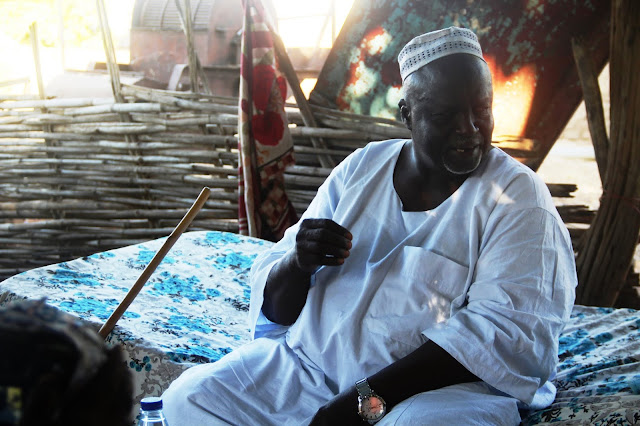CAR diaries: A place called Birao
 |
| The Sultan of Birao, Mustapha Ahmed Amgabo was almost killed by an armed group last year. he was saved by Zambian troops. |
 |
| Leonard Mbele is the prefect of Vakaga. |
 |
| The star that has come to symbolise Birao. |
 |
| A woman rides a donkey in Birao. Pictures by Jack Zimba |
CAR diaries: A place called Birao
JACK ZIMBA
Birao
THERE is a place, somewhere in the northern part of Central African Republic
(CAR), near the border with Sudan, called Birao.
It is the administrative centre for Vakaga Prefecture (province). The CAR is
divided into 16 prefectures.
I had heard a lot about Birao from a Zambian soldier who once served here as a
peacekeeper in 2015.
By then, Birao was a rebel territory,
and off-limits to both government and United Nations (UN) staff.
But in 2015, the place was taken by Zambian troops under a UN mission known by
its French acronym, MINUSCA.
And now, here I was sitting in an Antonov 74-100 plane operated by the UN,
heading to Birao from Bangui, the capital city of CAR. I still wasn’t sure what
to expect once I landed in Birao.
The journey would take me right across the country.
Bangui lies on the border with the Democratic Republic of Congo to the south,
while Vakaga Prefecture shares a border with Sudan and Chad – a region that was
popularly known as the triangle of death because of the cross-border rebel
activity.
There is no paved road connecting Bangui to Birao, and so it usually takes
three days to cover the 1,000km.
But twice a week, a UN plane flies to Birao to transport passengers, mostly UN
staff.
After flying for one hour and 10 minutes, the small plane made a bumpy landing on a gravel runway at Ndele to drop off a Pakistani peacekeeper and a few small parcels.
Ndele, like many parts of this vast country, is a rebel territory controlled by the FPRC (Popular Front for the Rebirth of CAR). But troops from the Pakistani army have fortified the airport to prevent attacks.
A few minutes later, we took off in a cloud of dust, having picked up three or four more passengers.
Below lay a vast wilderness, unbroken
by any kind of civilisation – no paved road, no power lines; no railway or
commercial farm.
Fifty minutes later, we finally landed on a gravel runway at Birao airport
(actually Bangui has the only paved runway in the whole Central African
Republic, the rest are gravel).
The airport at Birao is under the control of Zambian troops serving under MINUSCA.
The troops are well-known by their mission code, ZAMBATT VI (which stands for Zambian Battalion six).
For a little moment after landing, it felt like home as we were surrounded by the familiar camouflage of the Zambia Army.
But that feeling did not last.
Soon, we were given bullet proof vests and helmets and driven under escort –
sandwiched between two gun trucks - to the ZAMBATT headquarters.
It is a large compound surrounded by a high wall with sentry posts, located about 12 kilometres from the airport.
The war in CAR has drawn in over 50 countries which are trying to regain regions from armed groups. There are about 14 recognised armed groups in the country.
Zambian troops are deployed in Birao and in Bria, which is the capital of Haute-Kotto Prefecture. Some more troops are deployed in Ouaka Prefecture.
Initially no country was willing to take Birao because it was considered a suicide mission. It was one of the strongholds of the FPRC.
But today, at the very place where the camp for the FPRC was located, is where the ZAMBATT headquarters sits.
And it would be our home for the next six days.
Days before travelling to CAR, I had
inquired from a soldier who had served here if I could get hotel accommodation.
He laughed as if I had asked the most absurd question, and now arriving here, I
was laughing at myself for having asked the question.
The ZAMBATT base, which is made up of permanent structures and some prefab shelters, is the best place in Birao – the only place that has electricity and piped water.
The whole of Vakaga Prefecture has not a single power line, and there is not an inch of tarmac.
Birao is a sleazy, dusty place, devoid of any industry at all.
It looks like a historic place.
Majority of its inhabitants are herders, keeping goats, sheep and donkeys, and
dwelling in simple houses made of poles and mud, and fenced around with bamboo.
But more than half of Birao’s population – about 12,000 - lives in camps for
internally displaced persons (IDP) under the protection of ZAMBATT.
All the IDP camps are located in the shadow of ZAMBATT. It is the only place that guarantees safety in this region.
But a lot of people in Birao are also said to have crossed the border into Sudan as refugees when the fighting escalated.
ZAMBATT has a stronghold on Birao – it is both feared and loved by its residents.
The local leaders speak highly of the Zambian troops, and children usually cheer them on as they drive around.
“Our hope is that ZAMBATT stays with us until the end of the mission,” said Mustapha Ahmed Amgabo, who is the sultan and mayor of Birao.
“We don’t want any army from another country,” he said.
The sultan has every reason to praise
ZAMBATT.
One Sunday morning in February last year, the sultan was almost killed by an
armed group which attacked him at his house. They managed to kill his son
earlier.
The sultan owes his life to the Scorpion – a small band of quick response team under ZAMBATT.
But the sultan, himself, is wanted by the International Criminal Court for war crimes.
Birao may be quiet now, but no one takes things for granted within the Zambian camp. CAR is a country on the edge.
“Anything can happen here” had become a catch-phrase since I arrived here on December 26.
And throughout my stay in Birao, I was always required to wear a bullet proof vest and helmet whenever we went out of the base, and our vehicle was always escorted by gun trucks – Toyota Land Cruisers mounted with a 12.7mm machine gun.
But still, a lot has changed here.
“Over the years ZAMBATT has pacified this area and has enabled other actors to come on board because of the conducive security environment that has been provided,” said Lieutenant Colonel Paul Sapezo, who commands the Zambian battalion.
Birao is now a weapon-free zone where no civilian is allowed to move with a gun, not that the residents do not have weapons, most of them do.
And there is now a small presence of
the national army called FACA, although its fighters look like a rag-tag army.
The government has also set up an administration office headed by a prefect
(equivalent of provincial minister).
The office is in a Spartan building
on the main road.
Behind a small table sat Leonard Mbele, the prefect of Vakaga.
On his table stood a desk flag for his country, and beside it, a plaque bearing his country’s and Zambian flags, and the unmistakable buffalo – symbol of the Zambia Army. Here, it has come to symbolise safety.
There was a similar plaque sitting on the dusty window sill.
The prefect’s office is dusty because
there are no glasses in the window, only chicken wire and another wire mesh to
keep the mosquitoes away.
A dusty cabinet sat in one corner with a few documents in there, but a spider
had found enough time to weave a web across its open door.
The wall behind the prefect’s seat
had a big crack running from the ceiling down to the floor, and on it hung a
neat portrait of President Faustin-Archange Touadera.
He has just won a second term in office, in elections held on December 27. He
now has a huge task to fix the crack that deeply divides his county along
ethnic, religious and political lines.
And long after peace has fully been restored in CAR, Birao will still be grappling with development challenges.
It will have to be built from
scratch.
Birao has the only hospital in the whole Vakanga Prefecture. But it is small –
less than 20 beds – and is rundown.
The hospital is manned by Dr Xavier Gvassapa, who does not hide his
frustration, complaining about the state of his hospital. It is easy to
understand why.
He is the only qualified medical worker at the hospital, and he is assisted by one unqualified nurse.
The hospital is also ill-equipped. Actually, the best hospital in the whole of Vakaga Prefecture is the one run by ZAMBATT within the camp.
It is a level one hospital, and has the only dental theatre in the whole of Vakaga.
There are three small schools in Birao, but they have no teachers and rely on volunteers.
But there is a small ray of hope for Birao.
One night I joined the Scorpion team for patrol in their armoured vehicles.
It was almost 21:00 hours and most of the traders at the only market in Birao had gone home, but a few lingered for a last transaction. Just some months ago, this scene was not possible, as Birao was considered too dangerous.
On the only traffic circle in Birao, is a monument of a yellow star – the symbol of Birao.
Maybe one day, this star shall rise and shine.



Comments
Post a Comment